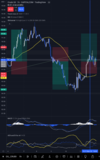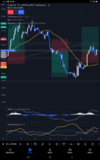Hey, I'm looking to make money trading (long-term..)
I was told by somebody on here, that maybe starting a journal on here might be good for me seeing as I don't trade $5000 or anything else like that until I can consistently make money paper trading. I understand that paper trading is not "real" trading but like I said I'm not going to risk blowing up my account - shame I can't start with a small account and grow my account, going forwards... anyways, after watching these videos;
I've decided to use a 50 day moving average, the MACD and ADX - this isn't the first time in the markets, nahhh I was stupid and blew my all my savings - just reading hurts but you learn from mistakes I suppose? Anyway, this meant stop seriously trading for a 4 to 5 years when it comes two entries and exits I'm going do it the right way this time and only going to look to take a long positions, when set-up happens...
Price above 50 day moving average
ADX above 25
MACD signal line on the upside
And only take a short position when..
Price below 50 day moving average
ADX above 25
MACD signal line on the downside
Unlike when I blew my account and savings with it - I will draw up support and resistance lines/ swing highs and swing lows - the plan is to set my stop loss at a recent swing high or swing low and look for a 1:2 take profit set-up... cos I'll set stop and take profit levels, chasing profits, getting out of trades early won't happen - unlike last time - well that's the plan.
I was told by somebody on here, that maybe starting a journal on here might be good for me seeing as I don't trade $5000 or anything else like that until I can consistently make money paper trading. I understand that paper trading is not "real" trading but like I said I'm not going to risk blowing up my account - shame I can't start with a small account and grow my account, going forwards... anyways, after watching these videos;
I've decided to use a 50 day moving average, the MACD and ADX - this isn't the first time in the markets, nahhh I was stupid and blew my all my savings - just reading hurts but you learn from mistakes I suppose? Anyway, this meant stop seriously trading for a 4 to 5 years when it comes two entries and exits I'm going do it the right way this time and only going to look to take a long positions, when set-up happens...
Price above 50 day moving average
ADX above 25
MACD signal line on the upside
And only take a short position when..
Price below 50 day moving average
ADX above 25
MACD signal line on the downside
Unlike when I blew my account and savings with it - I will draw up support and resistance lines/ swing highs and swing lows - the plan is to set my stop loss at a recent swing high or swing low and look for a 1:2 take profit set-up... cos I'll set stop and take profit levels, chasing profits, getting out of trades early won't happen - unlike last time - well that's the plan.
Last edited:





